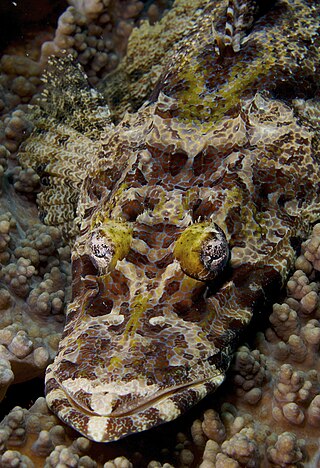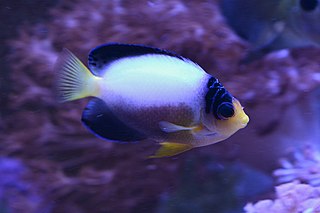
The longfin catshark is a catshark of the family Scyliorhinidae found in the western Pacific from Japan to the Philippines, and the East and South China Seas, and the Kyūshū-Palau Ridge, at depths between 530 and 865 m. Its length is up to 48 cm.

The largemouth triplefin, Ucla xenogrammus, is a fish of the family Tripterygiidae and only member of the genus Ucla, found in the Pacific Ocean from Viet Nam, the Philippines, Palau and the Caroline Islands to Papua New Guinea, Australia, and the Solomon Islands, Fiji, Tonga, east to American Samoa and Rapa Iti, at depths of between 2 and 41 metres. Its length is up to about 47 millimetres (1.9 in). The generic name was coined by ichthyologist Richard Heinrich Rosenblatt in his unpublished dissertation of 1959 from the University of California Los Angeles and it is the initials of that institution, it was formally applied by Holleman in 1993.

De Beaufort's flathead, also known as the crocodilefish or giant flathead, is a species of marine ray-finned fish belonging to the family Platycephalidae, the flatheads. It is found in the Western Pacific Ocean.
Eleotris pellegrini is a species of fish in the family Eleotridae endemic to Madagascar where it can be found in mangrove swamps. This species can reach a length of 23 cm (9.1 in). The specific name honours the French ichthyologist Jacques Pellegrin (1873-1944), who discovered this species in 1933 but thought that it was Eleotris vittata.
The Mitchell gudgeon is a species of fish in the family Eleotridae endemic to the Kimberley region of Australia, where it is only known from the Mitchell River system. This species can reach a length of 4 cm (1.6 in). The specific name honours the ichthyologist J. Barry Hutchins of the Western Australian Museum, who collected the type.
Milyeringa veritas is a species of fish in the family Milyeringidae. It is endemic to groundwater and anchialine systems in caves in the Cape Range, Australia. Like other cave-adapted fish, the blind gudgeon is entirely blind and lacks pigmentation, using sensory papillae on its head and body to move around and find food. It has a reduced number of scales on its body and the head is almost scaleless. It reaches a standard length of 5 cm (2.0 in). It is listed as vulnerable under the Australian Environment Protection and Biodiversity Conservation Act 1999. It is an omnivorous species which feeds on algae and possibly also detritus, as well as invertebrates. Invertebrates consumed by M. veritas include Stygiocaris sp., aquatic insect larvae such as those of caddis flies and non aquatic invertebrates which accidentally fall into the water such as isopods, ants and cockroaches. When the gut contents have been sampled 10% of the identifiable gut contents were Stygiocaris and 70% were terrestrial species, despite this species being restricted to caves. They are often observed hanging still in the water column or resting on ledges in the cave walls, behaviours which they also display when kept in aquaria, but can move quickly to avoid capture if threatened, for example when catching them with a net is attempted. The generic name is taken from Milyering which is 20 miles (32 km) southwest of Vlamingh Head in the North West Cape of Western Australia, the type locality, and the specific name is Latin veritas meaning truth an allusion to a quote attributed to the Ancient Greek philosopher Democritus "Truth lies at the bottom of a well, the depth of which, alas! gives but little hope of release.”
Milyeringa is a genus of blind cavefish from the Cape Range and Barrow Island, northwestern Australia. Although traditionally considered to belong to the family Eleotridae, studies show that they represent a distinct and far-separated lineage together with the Typhleotris cavefish from Madagascar, leading some to move them to their own family, Milyeringidae. The generic name is taken from Milyering which is 20 miles (32 km) southwest of Vlamingh Head in the North West Cape of Western Australia, the type locality for Milyeringa veritas.

Ratsirakia legendrei is a species of fish in the family Eleotridae endemic to fresh waters of Madagascar. This species can reach a length of 17 cm (6.7 in). It is the only known member of its genus. It is the only species in the monotypic genus Ratsirakia, the name of which honours Didier Ratsiraka who was President of Madagascar from 1975-1993 and from 1997-2002 while the specific name refers to the French physician Jean Legendre who discovered the species while serving with French colonial troops in Madagascar.
Typhleotris pauliani is a critically endangered species of fish in the family Milyeringidae that is endemic to Madagascar, where it is only known from a few caves and sinkholes in the southwestern portion of the island. This blind cavefish lacks pigmentation and can reach a standard length of 7.1 cm (2.8 in). It feeds on invertebrates and guano. Part of its range receive some protection, but the species is threatened by disturbance from recreational activities and collectors of guano. The specific name honours the French entomologist and former deputy director of the Institut de recherche pour le développement in Madagascar, Renaud Paulian (1913-2003), who collected the type specimens as well as contributing a lot to the knowledge of the biogeography of the western Indian Ocean.

Centropyge multicolor, the multicolor angelfish or pearlback angelfish, is a species of marine ray-finned fish, a marine angelfish belonging to the family Pomacanthidae. It is from the Pacific Ocean that sometimes makes its way into the aquarium trade. It grows to a size of 9 cm in length.
Dorothea's wriggler, Allomicrodesmus dorotheae, is a species of fish in the monotypic genus Allomicrodesmus which is regarded by some authorities as being in the family Xenisthmidae, the wriggler family, but in the 5th edition of Fishes of the World this is treated as a synonym of the family Eleotridae, sleeper gobies. It is 5 cm (2.0 in) in length. It is known from just two specimens, one from the Great Barrier Reef and the other from the Marshall Islands. It has been collected from a depth of around 10 m (33 ft) in a channel in a reef. The specific name honours Dorothea Bowers Schultz, the wife of Leonard Peter Schultz, who illustrated the monograph in which this species is described, although not this species.
Rotuma lewisi, or Lewis's wriggler, is a species of fish in the family Xenisthmidae, which is regarded as a synonymous with the Eleotridae. Rotuma is a monotypic genus. The generic name refers to the volcanic island of Rotuma, north of Fiji while the specific name honours Anthony D. Lewis, a Fisheries Officer of the Government of Fiji who supported Springer's field work in Fiji. It has been recorded from Fiji, Tonga, the Santa Cruz Islands, the Comoros Islands, and the Chesterfield Islands.
Paraxenisthmus springeri is a species of fish in the genus Paraxenisthmus of the Xenisthmidae (wriggler) family, which is regarded as a synonymous with the Eleotridae, from the West Pacific. Its specific name honours the American ichthyologist Victor G. Springer of the U.S. National Museum for his contributions to fish systematics.
Paraxenisthmus is a genus of goby from the western Pacific. They were classified as being in the family Xenisthmidae but this family is regarded as a synonym of the Eleotridae.
Rhyacichthys guilberti is a goby belonging to the family Rhyacichthyidae. This fish only occurs in the Northern Province of New Caledonia and in Vanuatu. It is found in only two rivers. Its maximum standard length of about 240 mm. Its population on New Caledonia was estimated at less than 400 individuals, but it is now thought to have been extirpated from that island, it remains common on Vanuatu.

Mangarinus waterousi is a species of goby native to fresh and brackish waters of Japan, the Philippines, Indonesia, Palau and Micronesia. This species grows to a length of 4.8 centimetres (1.9 in) SL. This species is the only known member of its genus. The specific name honours the Medical Corps physician Willard H. Waterous (1890-1964) who was a friend of the author, A. W. Herre, and who allowed him to use the Hacienda Waterous on Mindoro, where he collected the type.
Milyeringa justitia, commonly known as the Barrow cave gudgeon, is a species of fish in the family Milyeringidae endemic to groundwater systems (aquifers) of Barrow Island, around 50 km off the Pilbara coast in Western Australia. This troglobitic species has a pale body, lacking in pigment, and it is eyeless and blind, using sensory papillae located on the head and body to allow it to feed and move around in total darkness. The specific name justitia is Latin for "justice" and was given by the describers to complement the specific name of Milyeringa veritas which means "truth" in the hope that “As truth and justice are supposed to go together, we name this species justitia, from the Latin for justice, in the hope that justice helps the species to survive on Barrow Island, which has been an oilfield since 1967 and is most recently the site of the Gorgon Gas Hub development.” Very little is known about M. justitia as between 2002 and 2013 only six specimens were collected but its biology is assumed to be similar to that of M. veritas.
Caecieleotris morrisi, also known as the Oaxaca cave sleeper is a species of troglobitic fish in the family Eleotridae found in a single cave system beneath Presa Miguel Alemán reservoir, northern State of Oaxaca in Mexico. This species is the only member of its genus.

Milyeringidae, the blind cave gobies, is a small family of gobies, in the order Gobiiformes. There are two genera and six species within the family, which is considered to be a subfamily of the Eleotridae by some authorities. Milyeringidae includes one genus (Milyeringa) restricted to caves in the North West Cape region of Australia and the other (Typhleotris) to underground water systems in Madagascar. They are all troglobitic species and have lost their eyes.
Protogobius attiti is a species of loach goby which is endemic to nine rivers in South Province, New Caledonia. It occurs in rivers with ultramafic beds. It prefers areas where there is a gravel substrate under overhanging vegetation in slower reaches of fast flowing, clear streams. The rocks and gravel in the areas in which it occurs are usually coated with detritus. When threatened it buries itself in the gravel leaving its eyes, mouth and first dorsal fin above the substrate. Its main prey is small freshwater crustaceans, especially the abundant transparent shrimp which occur in these streams. It is threatened by nickel mining which creates sediments which blanker the rocks on which it hides and destroys the algae its prey feed on. The specific name honours a Melanesian chief of Goro, New Caledonia.







